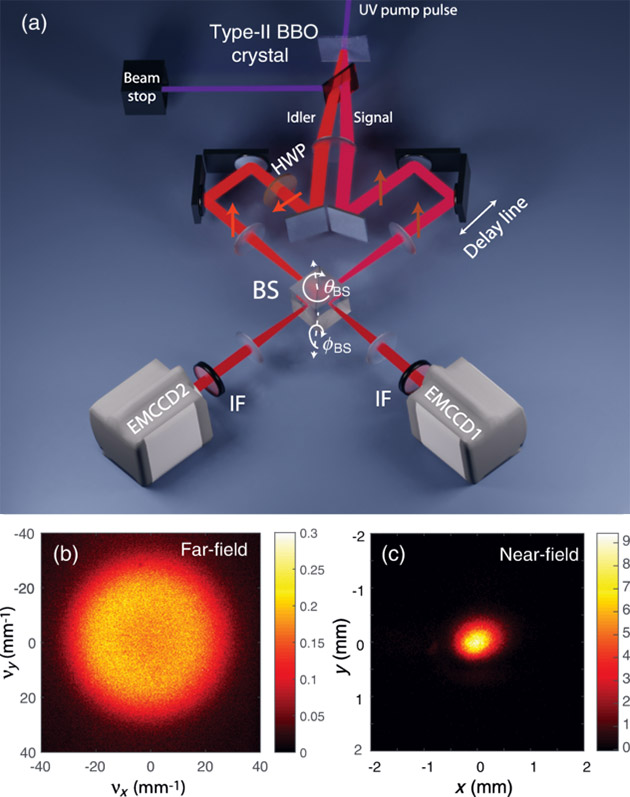Resources
 Part of the Oxford Instruments Group
Part of the Oxford Instruments Group
Expand
Collapse
 Part of the Oxford Instruments Group
Part of the Oxford Instruments Group
In August 2020, the article ‘Imaging spatiotemporal Hong-Ou-Mandel Interference of Biphoton States of Extremely High Schmidt Number’ was published in the Physical Review Journal [1]. First author Dr Fabrice Devaux, full professor at the University of Franche-Comté in Besançon, currently conducts his research at the Optics Department of the FEMTO-ST Institute. His research focuses on theoretical and experimental studies of optical and quantum imaging using various approaches. Dr Devaux published several articles covering applications like Quantum Holography [2,3], Ghost Imaging [4] as well as measuring quantum correlations through a scattering medium [5].
In the presented article [1], Dr Devaux and collaborators discuss the experimental observation of spatial and temporal Hong-Ou-Mandel (HOM) interference of highly entangled photon pairs. In principle, a HOM experiment is based on pairs of photons, which can be generated in a crystal by splitting photons from a laser beam into lower frequency pairs. This is a phenomenon called spontaneous down conversion (SPDC). The resulting photon pairs then interfere at a beam splitter. Upon exiting the beam splitter, the photon pairs are detected at the same but random output port, which requires the use of highly sensitive detectors operating in photon-counting mode.
In Dr Devaux’s HOM interferometer setup (see Fig. 1), two Andor iXon Ultra 897 EMCCDs in photon counting mode are used to detect spatial coincidences at the output ports. The indistinguishability of the generated photons is a key parameter in this experiment and is controlled spatially, temporally, in polarization and in wavelength. Until recently, HOM interference was observed only in the temporal domain using bucket detectors. However, Dr Devaux and his collaborators demonstrate in their study how to obtain spatial and temporal resolution of HOM interference. Through their experimental setup, the researchers are able to measure HOM interference spatially and temporally with a visibility of 60% of over 4000 pairs of photons of extremely high dimensionality.

Figure 1: (a) Experimental setup showing the HOM interferometer’s photon source (Type-II BBO crystal), the beam splitter (BS) as well as the two Andor iXon Ultra 897 EMCCDs to detect photon pairs at the output ports. (b,c) The two figures show average images of the far field and near field of the SPDC beams.
This demonstration of measuring and obtaining HOM interference through the manipulation of quantum states of very high dimensionality is important for future developments of quantum information protocols, such as quantum information processing and teleportation.
"It is superb to see Andor’s flagship single photon counting technology being used so convincingly in landmark quantum experiments, such as the one led by Dr Devaux. A lot of innovation effort has gone into optimizing the iXon EMCCD exactly for such challenging systems, where the ability to distinguish a photon event with a high degree of confidence is pivotal."
Dr Colin Coates, Product Manager, Andor
[1] Devaux, F. et al., Physical Review X (Volume 10, Issue (3), 2020): Imaging Spatiotemporal Hong-Ou-Mandel Interference of Biphoton States of Extremely High Schmidt Number. https://doi.org/10.1103/PhysRevX.10.031031
[2] Devaux, F. et al., International conference on quantum Metrology and Sensing (IQuMS) (2019): One-photon and two-photon quantum holography with bi-photon states of large spatial dimensionality
[3] Devaux, F. et al., Physical Review A (Issue (99), 2019): Quantum holography with biphotons of high Schmidt number. https://doi.org/10.1103/PhysRevA.99.033854
[4] Denis, S. et al., Journal of Optics (Volume 19, Issue (3), 2017): Temporal ghost imaging with twin photons. https://doi.org/10.1088/2040-8986/aa587b
[5] Soro, G. et al., OSA Continuum (Volume 2, Issue (12), 2019): Imaging Spatial Quantum Correlations through a thin Scattering Medium. doi:10.1364/OSAC.2.003393
